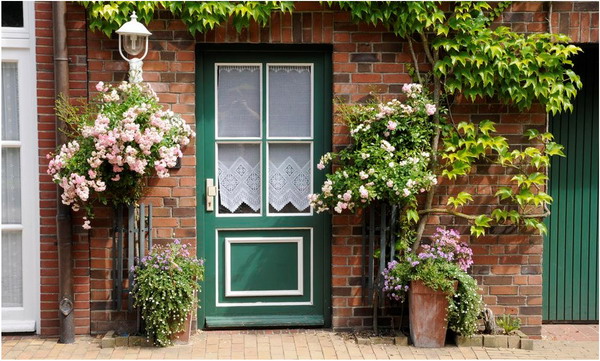The front door is the business card of the house and can tell a lot about the inhabitants.
A front door is intended above all to provide security. Also important is sufficient insulation so that the heat stays in the house and no energy is wasted. And last but not least, the front door should harmoniously fit into the façade of the house and be visually pleasing.
Criteria when buying a front door
Whenever you or your guests approach the property, the front door immediately catches the eye. It serves as one of the first optical contact points and should fit seamlessly into the overall picture of the house. Ideally, you should therefore choose both the material and the design to match the overall look. Create additional harmony by using front door and garage door similar design. If there is not enough light in the entrance area, you can install windows in the door. Be sure to use heat protection glass for insulation reasons. Additional protection against burglars offers laminated safety glass. The prescribed quality criteria in terms of weather resistance, stability, thermal insulation, longevity and burglar resistance defines the product standard DIN EN 14351-1 for entrance doors. In addition, you should pay attention to the regulations of the Energy Saving Ordinance when purchasing: New entrance doors must comply with the requirements of EnEV 2014.
Good to know: In the meantime, you can integrate your front door into a smart home system and control it via app or sender. Particularly useful is the function that the front door automatically opens when someone approaches. Ideal if, for example, you have your hands full of purchases or the key is not at hand.
What security precautions are possible?
Weather resistance, thermal insulation, burglar resistance: For house doors, certain standards and regulations apply in Germany.
Basically, a front door as a movable gap in the masonry is a weak point. However, if you comply with the resistance classes of the European test standard DIN V ENV 1627 when purchasing, it no longer represents a safety risk. The different resistance classes from RC1 to RC6 serve you as orientation. RC stands for “Resistance Class.” The higher the value, the safer your front door.For your house or apartment, the police recommends doors that conform to RC2 or RC3. Also, make sure that your front door is either DIN or VdS approved. Multi-point locking systems also contribute to increased safety standards, and you can combine burglary-resistant locking cylinders with additional bolts – up to nine are possible.
Using a security striking plate makes it difficult to pry open a door in the area of the lock. Electronically, you can increase security with the help of a fingerprint scanner, which opens the front door only when pre-determined people place their finger on the sensor. So you cling the keyhole as a vulnerability. An electronic alarm system or a motion detector, which automatically switches on the lighting in the entrance area as soon as someone approaches, increases the security around your front door.
Our tip: Consider seriously if you do not have your front door installed and installed by a specialist. Experts make sure that your front door and extra safety precautions are properly installed. So there is no weak point, because something is not sitting properly or the door was installed slightly shifted.
Front doors with thermal insulation
With a well-insulated entrance door you not only have it cozy and warm inside the house, you also save heating costs. In any case, clear guidelines for heat protection apply to front doors. The minimum requirements are specified in the test standard DIN 4108-2 and in the Energy Saving Ordinance. Decisive for a proper and efficient thermal insulation are besides the construction the material as well as the seals of a front door. Woodbrings with it the best features, but also aluminum and plastic now reach a high level of insulation. You also have the opportunity to use the advantages of different materials with material combinations. Aluminum-wood compounds are considered to be particularly effective and of high quality, but also cause higher costs when they are purchased. Basically, you should pay attention to the lowest possible heat transfer coefficient (UD value) when buying. Higher values stand for less efficient insulation. According to EnEV, the UD value may currently be a maximum of 1.8 W / (m² • K) – watts per square meter and Kelvin. In addition, the door needs around the frame around running seals – the installation is best left to a professional.
Good to know: the more energy-saving your front door is, the higher the potential funding from KfW will be . The minimum requirement is a UD value of 1.3 W / (m² • K). But there is more. With house doors that even bring it to 0.7 W / (m² • K), you not only get subsidies, but also save energy costs in the long run.
Front door: materials and their properties
| material |
recommendations
|
advantages | disadvantage |
| plastic |
· Air chamber system improves · Steel or aluminum frame
|
· Good price-performance ratio (especially for high-impact PVC)· Long durability · Cheap maintenance · Easy care material · Cheapest variant · Great design and color selection |
· Hardly protects against sound · Less stable than wood · Less weather
|
| aluminum |
· Polyurethane foam as
|
· stability
· Hardly care and maintenance · It hardly disappears · High security · Durable · resistant |
· Material · High acquisition costs
|
| Wood | · High-quality doors better withstand tensions that arise with heat- cold-contrast· Impregnations protect wood from the weather |
· Pleasant, high quality look
· By nature, · Protects against noise and noise · Very good statics |
· Intensive care (oil, wax, color)
· Elaborate processing
|
The cost of a front door
Of course, a decisive cost factor is the material used. Basically you get an entrance door already from 400 euros. You can also invest 10,000 euros as well. The cheapest variants are plastic models, which may cost 4,000 euros, but are often located in the lower price segment. Aluminum doors offer more stability, but only start at around 1,500 euros, while you pay at least 1,000 euros for a front door made of wood. It will be more expensive if you have your door custom-made.
When buying, also pay attention to the cost of installation, because even there are differences. What is your entrance area? Which front door did you choose? Such questions affect the difficulty of the installation, so the time and ultimately the price. Specialist companies demand on average between 30 and 40 euros per hour. You indicate your prices either for the square meter or for the running meter (Lfm). Additional costs may be incurred for the disposal of your old door. In general, the replacement of a front door is usually more expensive than the installation in a shell – the removal of plaster and masonry eats time.
Tips: Install the front door yourself
Practiced do-it-yourselfers can install a front door themselves – untrained should better leave the installation to an expert. So you can rest assured that the door sits exactly at the end. This is crucial to ensure insulation, sound and burglary protection. The individual steps:
- Measurements: Measure the height and width of the inside dimension by means of a rule – the specialist speaks of the reveal – of your door opening. Use at least three digits and make a note of the values. Remember to remove the panel before measuring.
- Preparing: Now build your old front door. First you hang out the door leaf – the actual door -, then saw the door frame in several places and knock off the plaster on its inside with a chisel or rubber mallet. Then use the angle grinder to remove the exposed wall anchor. Now carefully remove the old door frame.
- Door frame: Place the door frame in the interior of your door opening and adjust it there with a spirit level and a ruler. If you have fixed it with wedges, use frame anchors to attach it firmly to the wall. Another important tip: Avoid drilling the wall joints.
- Threshold: Since the threshold has to carry a lot of weight day after day, make it a stable foundation. It is best to paint concrete screed below the threshold and then follow the manufacturer’s instructions for the dry season. Only when everything is really dry can you proceed with the installation of your front door.
- Hook : Your frame anchor put first one on the page on which you mount the door. Once you have done that, hang the door leaf. It has to fit evenly in the frame and close smoothly. Only then put the screws on the side of the lock. However, not without hanging the door again before.
- Caulking: When installing your front door, a cavity is created between the masonry and the frame. To insulate it, fill it with mounting or insulating foam, but first remove the wedges you used to fix the frame in the door opening. There are leftovers? Just remove it with the utility knife. For moisture-prone areas, seal with diffusion-proof tape. On the outside there is thermal insulation render, inside interior plaster. At the end, use either cover strips or sealant around the frame.
- Completion: Check again if the front door closes smoothly and moves without resistance. If there is still a nibble, use the adjusting screws for fine adjustment. At the end of the door fitting is the turn.



